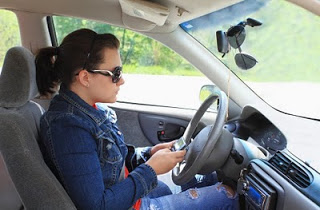Monthly Archives: October 2009

Teens and Drowsy Driving
October 29, 2009
Does the morning alarm seem to come too early in the day? Do you catch yourself daydreaming or having trouble focusing throughout the day? Do you find yourself rubbing your eyes or yawning? You may be suffering from Sleep Deprivation.
Being sleep deprived has a cumulative effect. The National Sleep Foundation (NSF) recommends 8.5 to 9.5 hours of sleep for teens to be fully rested and notes that other professionals recommend higher amounts. The less sleep you have, the more deprived you are and it continues to add up during the week.
Reduced amounts of rest affect judgment, performance, information processing, emotions, and reaction time. All factors which are heavily relied upon for everyday functions and especially important when operating a vehicle. The National Highway Safety Transportation Association (NHSTA) estimates falling asleep at the wheel is responsible for at least 100,000 automobile crashes, 40,000 injuries, and 1,550 fatalities nationwide per year. They have identified young people as a high risk population for drowsy driving.
Teens typically have full schedules, academic and social pressures to balance. Their body clocks change during this developmental time, calling for them to stay up later at night and wanting to sleep in longer in the morning. When teens drive without sufficient amounts of sleep, they are even more vulnerable to the dangers teen drivers already face including:
- Distracted driving due to cell phones, texting, other passengers, adjusting music and eating or drinking
- Inexperience
- Impulsive behavior, including reckless driving, tailgating and speeding
- Lack of consistent seat belt use
- Reduced visibility at dawn, dusk or night
Other risks that increase drowsiness include:
- Colds, viruses and the flu
- Many prescription and over the counter medications
- Sleep apnea
- Alcohol consumption
NHSTA has identified late night, late afternoon and morning hours between six and eight a.m. as the hours teens are most tired and in the most jeopardy. Getting enough rest and avoiding high risk behaviors at specific times help to prevent drowsy driving. Also consider asking a passenger to stay alert and share the driving responsibility.
How can you over come driving drowsy? The National Sleep Foundation has the following suggestions:
- Watch for the warning signs of fatigue
- Stop driving-pull off at the next exit, rest area or find a place to sleep for the night
- Take a nap-find a safe place to take a 15 to 20-minute nap
- Consume caffeine-the equivalent of 2 cups of coffee can increase alertness for several hours
- Try consuming caffeine before taking a short
Be safe and get some rest.
Learn more at the National Sleep Foundation (NSF). The NSF has established November 2-8 as Drowsy Driving Prevention Week.

Reaching for Items in Your Vehicle and Distracted Driving
October 26, 2009
The hazard drivers create when they text or talk on cell phones has received considerable attention in the popular press recently. However, a more common distracted driving hazard is reaching for an item in the vehicle. Though cell phone use while driving is a significant problem, National Highway Traffic Safety Administration (NHTSA) studies indicate that it is a relatively small proportion of the distracted driving issue.
Driving distractions occur anytime something takes your eyes off the road, your hands off the steering wheel, or your mental attention from the task. Some distractions involve two or even all three of these. When you look for a particular song on a CD or MP3 player, your eyes turn from the road ahead, you remove at least one hand from the steering wheel, and you are temporarily preoccupied by the task of searching for the song you want to hear.
Other “reaching” distractions include:
- Eating
- Smoking
- Manipulating the controls of the aforementioned stereo, an in-vehicle navigation system or the climate control system
- Reaching for a fallen object
NHTSA estimates that drivers participate in potentially distracting activities about 30% of the time their vehicles are moving. Distraction may result in:
- loss of vehicle control
- unintended speed changes
- leaving the lane of travel
- missed opportunities to respond to changes in the driving scene
Though a motor vehicle crash caused by a driver reaching for something in the vehicle is not easily proved unless the driver admits to it, most drivers are aware of having driven while distracted by reaching for something in the vehicle.
“Reaching for something” does not have to mean reaching for an inanimate object. When they reach out to soothe, protect or discipline their children and pets, drivers’ attention is removed from the driving scene. Driving requires all your concentration, and parents should teach their children this and reinforce the lesson when necessary. Children should be fastened into appropriate safety restraint systems. While distractions aren’t good for you as a driver, they are great for children as passengers; DVDs, books, games, and small toys can keep them occupied until you reach your destination. If your children need attention, find a safe place to pull off the roadway. Your furry friend can travel safely in a pet carrier or safety harness. Never let your pet ride in your lap or roam around the vehicle while you drive.
Other ways to manage distractions include adjusting all of the vehicle’s controls before you start to drive and during stops at traffic lights, asking passengers to assist you when you need to get something inside your vehicle, and taking breaks to eat, drink and smoke.
Learning how to manage the distraction of reaching for things in your vehicle is a daunting task because it occurs so frequently. But doing so will allow you to keep you, your passengers, and other road users safe when you’re behind the wheel.
Driver Education: Driving with a Cold or the Flu
October 5, 2009
With cold and flu season here, many drivers are hurrying to drug stores and pharmacies for tissues, hand sanitizer, and over-the-counter medications to relieve symptoms such as sneezing, coughing, fever, and body aches. Unfortunately, alleviating cold and flu symptoms won’t necessarily make them safer drivers.
Colds are characterized by sore throat, sneezing and runny nose, and coughing.
Although many people have little to no fever with colds, these effects can be debilitating. Aside from the distraction these symptoms cause, drivers are often irritable due to their degree of discomfort and drowsy because the symptoms make it difficult to sleep well. This collection of problems can mean that these drivers take chances they wouldn’t ordinarily take, such as turning left in front of oncoming traffic or running red traffic lights, in an effort to get home quickly.
Flu symptoms commonly include coughing and body aches, often with a high fever and chills. In addition to feeling ill-tempered and sleepy, these drivers may also suffer from disorientation and dizziness. Driving effects could include slower reaction time, poor coordination, and impaired judgment.
In an effort to continue their normal activities, some drivers choose to take over-the-counter medications to ease their cold or flu symptoms. However, these medications do not typically eliminate symptoms. They also wear off quickly and can have side effects that compromise the user’s ability to drive safely, such as:
- Dizziness or lightheadedness
- Loss of muscle control and motor coordination
- Increased reaction time
- Jittery feelings and nervousness
- Drowsiness
It’s best to stay off the road when you have a cold or the flu. Seek support from family and friends by asking for a ride to the doctor’s office if you need to go and arranging carpools for your children; you can repay these favors when you’re feeling better. Getting plenty of rest is the best way for you to recover from the cold or flu quickly so you can safely get back on the road.
